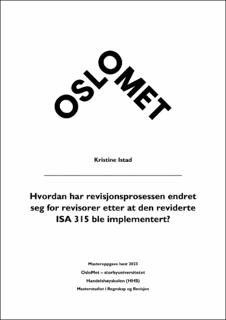Hvordan har revisjonsprosessen endret seg for revisorer etter at den reviderte ISA 315 ble implementert?
Master thesis
Submitted version
Permanent lenke
https://hdl.handle.net/11250/3122523Utgivelsesdato
2023Metadata
Vis full innførselSamlinger
Sammendrag
For my master thesis, I have investigated what has changed in the audit process for auditors following the revised ISA 315 being implemented. The purpose of the thesis is to gain a better understanding of how the revised ISA 315 has affected the audit process for auditors. I wanted to carry out this study to gain a better understanding of the auditing process, since I will be working as an auditor after my studies are completed.
I have used a qualitative method and exploratory design, where I conducted semi-structured interviews as a data collection method. I have interviewed eight auditors with between 3-22 years’ experience. Two of the auditors were from Riksrevisjonen and the last six auditors were from two of the big four audit companies. I used an interview guide, where I had both open questions and some more specific questions.
My results from the study concludes that auditors have change the audit process after the revised ISA 315 where implemented, manly phase two, known as the planning phase. Auditors spend more time on risk assessments, and documenting these and the understanding of the IT-environment. Auditors now make more use of specialists, they use IT-specialists and more experienced auditors. There was previously more focus on large numbers, significant balances, and changes in accounts, whereas auditors now take a step back and look at where the risk of material misstatement actually is. Auditor collects audit evidence in areas where there is detected risk of material misstatement. Therefore, the audit has become more focused on where there is risk of material misstatement compared to before the revised ISA 315 was implemented.
Based on the work on this thesis, I believe that further research can be done on whether the revised ISA 315 has led to better audit quality, or whether the audit process has become more efficient. Further research can also be done on whether the revised ISA 315 is helping to close the information gap between companies and users of the financial statements. I also think it could be fascinating to conduct a similar study to mine but wait a few years so auditors have more experience with the revised ISA 315.
